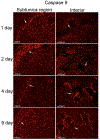Caspase Signaling in ED Patients and Animal Models
- PMID: 33707045
- PMCID: PMC8068676
- DOI: 10.1016/j.jsxm.2021.01.175
Caspase Signaling in ED Patients and Animal Models
Abstract
Background: Current treatments for erectile dysfunction (ED) are ineffective in prostatectomy and diabetic patients due to cavernous nerve (CN) injury, which causes smooth muscle apoptosis, penile remodeling, and ED. Apoptosis can occur via the intrinsic (caspase 9) or extrinsic (caspase 8) pathway.
Aim: We examined the mechanism of how apoptosis occurs in ED patients and CN injury rat models to determine points of intervention for therapy development.
Methods and outcomes: Immunohistochemical and western analyses for caspase 3-cleaved, caspase-8 and caspase-9 (pro and active forms) were performed in corpora cavernosal tissue from Peyronie's, prostatectomy and diabetic ED patients (n = 33), penis from adult Sprague Dawley rats that underwent CN crush (n = 24), BB/WOR diabetic and control rats (n = 8), and aged rats (n = 9).
Results: Caspase 3-cleaved was observed in corpora cavernosa from Peyronie's patients and at higher abundance in prostatectomy and diabetic tissues. Apoptosis takes place primarily through the extrinsic (caspase 8) pathway in penis tissue of ED patients. In the CN crushed rat, caspase 3-cleaved was abundant from 1-9 days after injury, and apoptosis takes place primarily via the intrinsic (caspase 9) pathway. Caspase 9 was first observed and most abundant in a layer under the tunica, and after several days was observed in the lining of and between the sinuses of the corpora cavernosa. Caspase 8 was initially observed at low abundance in the rat corpora cavernosa and was not observed at later time points after CN injury. Aged and diabetic rat penis primarily exhibited intrinsic mechanisms, with diabetic rats also exhibiting mild extrinsic activation.
Clinical translation: Knowing how and when to intervene to prevent the apoptotic response most effectively is critical for the development of drugs to prevent ED, morphological remodeling of the corpora cavernosa, and thus, disease management.
Strengths and limitations: Animal models may diverge from the signaling mechanisms observed in ED patients. While the rat utilizes primarily caspase 9, there is a significant flux through caspase 8 early on, making it a reasonable model, as long as the timing of apoptosis is considered after CN injury.
Conclusions: Apoptosis takes place primarily through the extrinsic caspase 8 dependent pathway in ED patients and via the intrinsic caspase 9 dependent pathway in commonly used CN crush ED models. This is an important consideration for study design and interpretation that must be taken into account for therapy development and testing of drugs, and our therapeutic targets should ideally inhibit both apoptotic mechanisms. Martin S, Harrington DA, Ohlander S, et al. Caspase Signaling in ED Patients and Animal Models. J Sex Med 2021;18:711-722.
Keywords: Apoptosis; Caspase; Cavernous Nerve Injury; Erectile Dysfunction; Extrinsic; Intrinsic; Penis; Peripheral Nerve Regeneration.
Published by Elsevier Inc.
Figures










Similar articles
-
Pathway Enrichment Analysis of Microarray Data Fom Human Penis of Diabetic and Peyronie's Patients, in Comparison With Diabetic Rat Erectile Dysfunction Models.J Sex Med. 2022 Jan;19(1):37-53. doi: 10.1016/j.jsxm.2021.10.004. Epub 2021 Nov 25. J Sex Med. 2022. PMID: 34838480 Free PMC article.
-
BMP4 and GREM1 are targets of SHH signaling and downstream regulators of collagen in the penis.J Sex Med. 2024 Apr 30;21(5):367-378. doi: 10.1093/jsxmed/qdae015. J Sex Med. 2024. PMID: 38451311 Free PMC article.
-
Sonic hedgehog suppresses penile remodeling after cavernous nerve injury and sustains long-term normal penis morphology.J Sex Med. 2024 Oct 31;21(11):986-993. doi: 10.1093/jsxmed/qdae116. J Sex Med. 2024. PMID: 39279183
-
Sonic hedgehog, apoptosis, and the penis.J Sex Med. 2009 Mar;6 Suppl 3(Suppl 3):334-9. doi: 10.1111/j.1743-6109.2008.01192.x. J Sex Med. 2009. PMID: 19267857 Free PMC article. Review.
-
Erectile dysfunction: anatomical parameters, etiology, diagnosis, and therapy.Arch Androl. 2005 Jan-Feb;51(1):15-31. doi: 10.1080/1485010490475147. Arch Androl. 2005. PMID: 15764414 Review.
Cited by
-
Advanced hydrogels: New expectation for the repair of organic erectile dysfunction.Mater Today Bio. 2023 Feb 20;19:100588. doi: 10.1016/j.mtbio.2023.100588. eCollection 2023 Apr. Mater Today Bio. 2023. PMID: 36896414 Free PMC article. Review.
-
hUC-MSC preserves erectile function by restoring mitochondrial mass of penile smooth muscle cells in a rat model of cavernous nerve injury via SIRT1/PGC-1a/TFAM signaling.Biol Res. 2025 Jan 27;58(1):8. doi: 10.1186/s40659-024-00578-y. Biol Res. 2025. PMID: 39871297 Free PMC article.
-
Peptide amphiphile nanofiber hydrogel delivery of Sonic hedgehog protein to the penis and cavernous nerve suppresses intrinsic and extrinsic apoptotic signaling mechanisms, which are an underlying cause of erectile dysfunction.Nanomedicine. 2021 Oct;37:102444. doi: 10.1016/j.nano.2021.102444. Epub 2021 Jul 24. Nanomedicine. 2021. PMID: 34314869 Free PMC article.
References
-
- Feldman HA, Goldstein I, Hatzichristou DG, Krane RJ, McKinlay JB. Impotence and its medical and psychosocial correlates: results of the Massachusetts Male Aging Study. J Urol 1994; 151: 54–61. - PubMed
-
- Heruti R, Shochat T, Tekes-Manova D, Ashkenazi I, Justo D (2004) Prevalence of erectile dysfunction among young adults: results of a large-scale 525 survey. J Sex Med 2004; 1: 284–291. - PubMed
-
- Nguyen HMT, Gabrielson AT, Hellstrom WJG. Erectile dysfunction in young men-A review of the prevalence and risk factors. Sex Med Rev 2017; 5: 508–520. - PubMed
-
- Selvin E, Burnett AL, Platz EA. Prevalence and risk factors for erectile dysfunction in the US. American J Medicine 2007; 120: 151–157. - PubMed
-
- Hakim LS, Goldstein I. Diabetic sexual dysfunction. Endocrinol Metab Clin North Am 1996; 25:379–400. - PubMed
Publication types
MeSH terms
Substances
Grants and funding
LinkOut - more resources
Full Text Sources
Other Literature Sources
Medical
Research Materials

